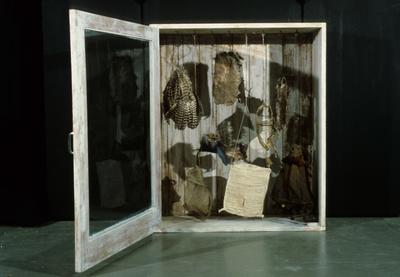Country Clothesline
-
Christine Hellyar
b.1947

Title
Country Clothesline
Details
| Production Date | 1972 |
|---|---|
| Collection(s) | Collection Govett-Brewster Art Gallery, New Plymouth |
| Accession Number | 77/4 |
| Media | 22 latex-dipped and dyed cotton, woollen and synthetic garments, plastic pegs, Agave sisalana (sisal) rope and wooden pole |
| Measurements | 2800 x 7200 x 900mm |
About
Christine Hellyar transforms everyday items into sculptures that provoke reassessment of familiar routines and objects. With works like Country Clothesline, Hellyar finds common humanity in ordinary domestic routine but also subtly interrogates our preconceptions about gender and the environment we live in. Earthy and monumental, Country Clothesline casts a long shadow across Hellyar’s practice because of its size and because of the controversy that surrounded its acquisition by the Govett-Brewster Art Gallery. Over seven metres in length when installed, Hellyar’s work provoked a correspondingly significant outcry when it was purchased by the Gallery.
Consisting of 22 items of clothing, dipped in rubber latex and hung from a primitive washing line made from flax rope with a wooden prop, Hellyar’s sculpture is provocative in the way it monumentalises a seemingly trivial domestic chore. Everyone who has hung out a load of washing has an idiosyncratic way of arranging the garments on the line. Do you pair the socks or hang them separately? Colour-code the pegs? In a friendly nod to small-scale, domestic creativity, Hellyar’s sculpture has no fixed arrangement but can be hung in whatever way suits the person installing the sculpture. This is also a political acknowledgement of the limited opportunities for creative expression in the traditionally female role of domestic drudgery.
Country Clothesline subverts the equation of feminine with pretty, or delicate. Hellyar’s latex-dipped clothes are fleshy, with a tactile and faintly repellent rubbery surface. They have an earthy weight which recalls landscapes and bodies. The items of clothing — woolly socks, heavy work trousers, lace-edged petticoats, cotton underpants — were chosen for their interesting textures, but also signify a rural lifestyle. Country Clothesline calls to mind frontiers; between people and the land, between natural and artificial forms. It imagines the New Zealand landscape as coastline. Wind-battered and salt-encrusted, we cling on.


